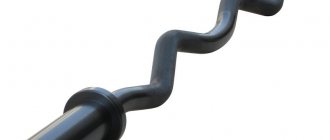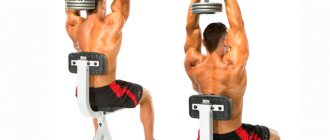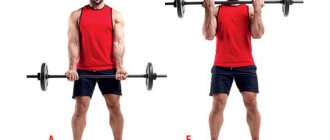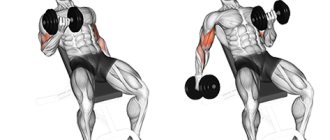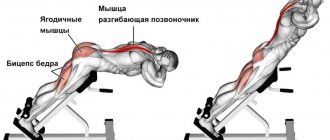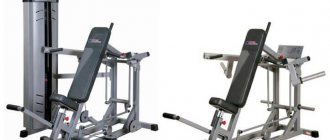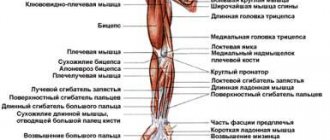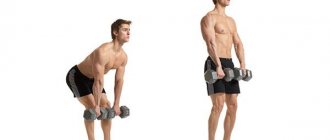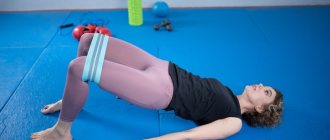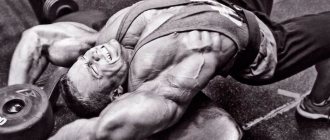Standing hammers are a common exercise for working the biceps. It is accessible to all levels of practitioners and can be performed with minimal equipment. It suits most people. But the problem is that many perform it with technical errors, throwing the dumbbells to their shoulders by the force of inertia, or making too many unnecessary movements. This is what keeps people away from building the most impressive biceps, and not the wrong choice of exercise. Fortunately, anyone can learn to make hammers; it's quite easy.
Execution technique
Initial position
- Choose a pair of dumbbells for warming up and for working sets. There is no point in giving any general recommendations here. According to the rules, the last two repetitions should be given hard, at the limit of strength. The weight is selected independently, based on this;
- Next, you need to take dumbbells in your hands with a neutral grip, palms facing each other, body vertical, spine neutral, you need a fairly well-tight stomach and collected shoulder blades;
- The forearms are pressed to the body, the position of the body is regulated by stabilizers, you cannot swing.
Movement
- From the stretched position, the dumbbells are brought to the shoulders by bending the elbows;
- The biceps works as the main mover and drives the dumbbells to the shoulders;
- You should stop at the point of maximum tension; you should not bring the dumbbells to your shoulders above this point, this does not lead to a better result;
- You can do the bends one at a time, or simultaneously. In the first option, attention is better concentrated on the work of the biceps, so most athletes are suitable for the alternating flexion option;
- Bending is done while exhaling, lowering while inhaling;
- You need to work smoothly and slowly until all repetitions are completed, the lifts are adjusted to the normal pace of breathing, and not vice versa.
It's "THE HAMMER", baby.
Attention
- Your elbows should be approximately in the plane of your spine. They do not need to be pulled back, reducing the amplitude of lifting and making movement easier. If this is the only way, you need to take lighter dumbbells;
- Bringing the elbows forward loads more of the forearm and also reduces the amplitude. This is a mistake;
- Swinging the body and throwing dumbbells due to the force of inertia is not allowed;
- It is better to refrain from fully straightening your arms at the lowest point of the amplitude. This can lead to overload of the elbow ligaments.
Recommendations
- Keeping your hands in the same plane, the dumbbell bars rise along two parallel elliptical paths. Otherwise, the turn will disrupt the lifting mechanics and lead to a technical error;
- Don't lift too quickly as you don't want to bounce the dumbbells off your forearms and lose muscle tension. In this exercise, it is important to always tense your biceps and not relax them at the lowest point.
Other benefits
The main advantage of the hammer is its complex effect, increasing the volume of the entire muscle group of the arms. By completing the task, you can pump up your biceps more effectively than their isolated counterparts. Hammer in the training program will provide:
- Double load on the muscles;
- strain on the wrists;
- strengthening small arm muscles;
- rapid increase in muscle mass;
- good hand definition;
- low risk of injury.
Common mistakes in performing the exercise are:
- Displacement of elbows;
- body swaying;
- weakened load;
- increased load.
To prevent displacement, the hands must be pressed against the body. The inertial force reduces the entire load to zero. For best results, the body should be as stable as possible. The shoulder muscles must be used to lift the projectile. A weakened load will not affect the process; sufficient weighting is necessary. However, a large mass of dumbbells is not allowed with the classical technique. The minimum dumbbell weight is usually 2 kg. The weight range usually varies, but there are certain limits on the number of discs that can be used.
Ask your question to the coach:
Execution options
Simultaneous bending of both arms using the hammer technique
This version of the exercise is suitable for those who have been training for a long time. It is more extensive than regular dumbbell curls, so may not be suitable for beginners. This option is good for those who can hold their hands fairly straight, in one plane, and lift dumbbells without tilting them to one side. This variation can be performed with heavier dumbbells and be the first or main exercise in a biceps workout. Alternating lifts usually complete the workout and are performed with lighter weights.
Hammer Front Raise
This is a kind of biceps curl, as if obliquely, the dumbbell goes to the opposite shoulder along an elliptical path in front of the body. The biceps curl in front of the chest involves the shoulders to a greater extent in the exercise. This option is loved by “mass monsters”, as it is technically more convenient for large hands, but you need to remember about balance and the need to isolate the working muscle group.
Con
The exercise is performed on a Scott bench, or with your elbow on your thigh in a sitting position. The hammers become “concentrated” when the elbow is placed on an incline bench and the arm is bent through its full range of motion. In this option, you take less weight, cheating with the body will not work even if you want to, the exercise is performed quite carefully and in a limited amplitude;
Hammers on an incline or Scott bench
In gyms where there is no Larry Scott bench, the exercise is performed on a regular “incline.” The forearm is placed on a bench inclined at an angle of 30 degrees, and the movement is performed with the arm fixed. In halls where there is a Scott bench, you can use it. This type of exercise is more isolated, it is good because you can work your arms with less weight, and also do not involve the body at the same time.
"HAMMER" Exercise for HUGE biceps!!! Kock technique!) VOD
Analysis of the exercise
What muscles work
- The main movers are the biceps and brachialis;
- How stabilizers work the brachyradialis, shoulders (anterior deltoid), core muscles, if we work while standing, and even the abs
pros
- This movement is often used to develop the ability to pull heavy weights while bending over on your back. It prepares the elbows and forearms for stress, allowing you to develop not only strength, but also endurance of small muscles;
- The exercise allows you to get rid of problems with insufficient development of one half of the body; it helps to create a symmetrical physique;
- A fairly simple technical movement suitable for beginners;
- Can be performed with the simplest equipment;
- The exercise is done at the end of the workout; it can be performed with light weight to avoid overstretching the ligaments of the elbow joints;
- The movement is suitable for beginners;
- Allows you to increase the total weight of your arms
Cons of the exercise
- Trainers often remove movements from more advanced amateurs' programs so that they can develop their biceps more harmoniously with higher isolation exercises. This movement, as it were, “blurs” the load between the biceps, brachialis, and muscles working statically. Many people don't like it;
What muscles work when lifting dumbbells with a hammer grip?
- Biceps brachii muscle.
- Brachialis.
- Brachioradialis.
- Pronator teres.
When performing the exercise while standing, the following muscles are included in the work as stabilizing muscles: the abdominal muscles, in particular the oblique abdominal muscles, leg muscles, and the serratus muscles also work as auxiliary muscles.
Preparation
Preparing for this movement is quite simple. It is not put at the beginning of the workout, so the joint warm-up is performed generally at the beginning; there is no need to do any special warm-up before bending with hammers. Typically, the “warm-up” is horizontal rows for the back, or other exercises for this muscle group. It is best to do the exercises so that it is not the first one in the plan, and then there will be no need for any kind of joint warm-up.
Before working approaches, a movement with light weight is performed in a number of repetitions of about 15-20 in order to fill the working muscles with blood and additionally engage the neuromuscular connections.
Proper execution
- Lifts are carried out while exhaling, the pace is quite slow, muscle contraction is concentrated. You should not bring the dumbbells up to your shoulders and keep them in this “empty zone”;
- Cheating and body swinging are not allowed in all movement variants;
- Hammers with a neutral grip are considered a universal movement that engages not only the biceps and brachialis, but also the brachyradialis. The distribution depends on the grip. If the palms are directed towards each other, the biceps work more; when turning with the palm down, the brachialis and brachioradialis muscles work;
- Elbows should be kept motionless and pressed to the body. They are not moved forward, backward or shifted in different directions;
- The exercise is performed with a relatively limited amplitude; you should not fully straighten your elbows and lift the dumbbells into a “dead hang.” As soon as the load on the biceps decreases, the trajectory should be shortened;
- It is not entirely correct to do this movement in “cardio mode,” that is, performing multiple swings of dumbbells in a large volume. It is better to do it quite concentrated and slowly to achieve maximum elaboration.
Errors
- The main technical mistake is “relaxing” the hands with dumbbells and lowering the apparatus along the body too quickly, so that they fall by inertia without the participation of muscles;
- There is no need to lift the weight by pushing with your legs and body;
- You should avoid bringing the dumbbells close to your shoulders;
- You cannot move your elbows away from the body in different directions.
Efficiency Tips
- The best way to perform this movement is to choose the weight so that it is optimal, does not overload the elbows, and does not force you to do hammers due to cheating;
- Beginners should start not with standing hammers, but with performing the exercise while sitting, in order to make the exercise certainly isolated;
- If the elbows diverge and move away from the body, it makes sense to lean your back against the wall, or stand with your spine close to any vertical support;
- At the top point you need to statically tense your muscles and stop
Standing dumbbell curl. Hammer grip #DarkFit
Basic mistakes
Of course, we have already discussed a lot and these points were mentioned in the paragraph above. But I wanted to say a little more about a few errors, namely:
Excessive weight of dumbbells
This is a very common mistake for beginners. It happens for several reasons.
- Excessive ego. Or the hero's instinct. Everyone wants to appear stronger. Especially for beginners, when they find themselves in the gym and are surrounded by guys working with large dumbbells. But don’t forget one thing, they, like you, were beginners and started with very small dumbbells. And instead of trying to imitate big dumbbells, ask them for advice on how you can achieve the same results.
- Incorrect interpretation of information. I think every beginner or professional has read some kind of literature. Or maybe you heard from your gym mates that the main criterion for muscle growth is: “Load progression.” And many, having heard this, immediately begin to grab the iron and harder, without thinking about the fact that they need to progress gradually.
Overweight dumbbells will not lead you to the result you are striving for. Arm muscles love not only heavy weight, but also intense training. And to achieve this, we need to increase the time during which the biceps is under load. Typically it varies from 30-50 seconds. At an average pace, this comes out to about 10-15 repetitions. Over time, you can increase this range slightly to 20 repetitions per set. And of course, do not forget about the execution technique, which is very important and reduces the risk of injury, while increasing the effect of the exercise. And with dumbbells that are difficult for you to even hold, it is unlikely that you will be able to maintain it.
Forced repetitions "Cheating"
Of course, we cannot say unequivocally that “cheating” is bad. In the right hands, this can turn into a good tool that will help increase the intensity of your workout. Or rather, work your biceps to the maximum. What he really is? This is a kind of slight swing of the body in order to do a few more repetitions. Professionals who know what they are doing are not afraid of this technique. Since they will still control the movement of the dumbbells and lift them using the triceps. Inexperienced athletes will most likely turn this into a swing. That is, they will begin to swing the dumbbells and body back and forth. At the same time, throwing them all the way up, bringing your elbows forward. As you can see, they violate all the rules of execution technique. All this, apart from injuries, will lead to nothing. Therefore, athletes who don’t know what’s what in “cheating” should refuse it. And even for experienced athletes, if possible, it is better not to use it.
Inclusion in the program
The movement may be the only biceps exercise in benchers' and powerlifters' programs. In bodybuilding and fitness, it is most often used as a “second” exercise along with barbell curls.
There may be other inclusion options. For example, hammers precede barbell curls so that a person can warm up properly.
Seto-repetition schemes can be different. Perform 8-12 repetitions or 15-20, depending on the weight and goal. In pumping mode, muscles are worked with less weight and a higher number of repetitions.
